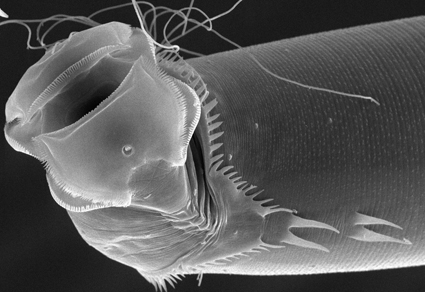Abstract
A new nematode species, Heth longquani sp. n. (Hethidae, Ransonematoidea, Rhigonematomorpha, Rhabditida) is described from the camballoid millipede, Chonecambala crassicauda from Thanh Hóa province, Viet Nam. The morphological features of this new species were studied with brightfield and scanning electron microscopies. Partial sequences of LSU rDNA and Cox1 mtDNA are provided. The phylogeny of the nematodes of the genus Heth Cobb, 1898 is discussed.
References
- Adamson, M.L. (1982) Two new species of Heth Cobb, 1898 (Nematoda, Rhigonematidae), from South American diplopods. Bulletin de Muséum National d’Histoire Naturelle, 4ème Série, Section A, 4 (3–4), 405–418. https://doi.org/10.5962/p.286045
- Altshul, S.F., Gish, W., Miller, W., Myers, E.W. & Lipmen, D.J. (1990) Basic local alignment search tool. Journal of Molecular Biology, 215 (3), 403–410. https://doi.org/10.1016/S0022-2836(05)80360-2
- Bowles, J., Blair, D.P. & McManus, D. (1992) Genetic variants within the genus Echinococcus identified by mitochondrial DNA sequencing. Molecular and Biochemical Parasitology, 54 (2), 165–173. https://doi.org/10.1016/0166-6851(92)90109-w
- Derycke, S., Vanaverbeke, J., Rigaux, A., Backeljau, T. & Moens, T. (2010) Exploring the use of cytochrome oxidase c subunit 1 (COI) for DNA barcoding of free-living marine nematodes. PLoS ONE, 5 (10), e13716. https://doi.org/10.1371/journal.pone.0013716
- Holterman, M., Van der Wurff, A., Van den Elsen, S., Van Megen, H., Bongers, T., Holovachov, O., Bakker, J. & Helder, J. (2006) Phylum-wide analysis of SSU rDNA reveals deep phylogenetic relationships among nematodes and accelerated evolution towards crown clades. Molecular Biology and Evolution, 23 (9), 1792–1800. https://doi.org/10.1093/molbev/msl044
- Hunt, D.J. (1994) A synopsis of the Hethidae (Nematoda: Rhigonematida) with descriptions of five new species of Heth Cobb, 1898 from diplopods from Papua New Guinea. Russian Journal of Nematology, 2 (1), 15–31.
- Kanzaki, N. & Futai, K. (2002) A PCR primer set for determination of phylogenetic relationships of Bursaphelenchus species within the xylophilus group. Nematology, 4 (1), 35–41. https://doi.org/10.1163/156854102760082186
- Kumar, S., Stecher, G., Li, M., Knyaz, C. & Tamura, K. (2018) MEGA X: molecular evolutionary genetics analysis across computing platforms. Molecular Biology and Evolution 35 (6), 1547–1549. https://doi.org/10.1093/molbev/msy096
- Malysheva, S.V. & Spiridonov, S.E. (2010) Four new species of Heth Cobb, 1898 (Rhigonematida: Hethidae) from Vietnamese diplopods. Nematology, 12 (4), 567–585. https://doi.org/10.1163/138855409X126018972397911
- Malysheva, S.V., Mohagan, A.B. & Spiridonov, S.E. (2015) Heth impalutiensis n. sp. (Nematoda: Ransomnematoidea: Hethidae) a millipede parasite from Central Mindanao, Philippines. Zootaxa, 3926 (1), 100–110. https://doi.org/10.11646/zootaxa.3926.1.4
- Malysheva, S.V. & Cribb, T.H. (2012) A new species of Heth Cobb, 1898 (Nematoda: Rhigonematida: Hethidae) from an Australian millipede (Myriapoda: Diplopoda: Spirostreptida). New Zealand Journal of Zoology, 39 (4), 301–309. https://doi.org/10.1080/03014223.2012.672435
- Malysheva, S.V. & Sumaya, N.H.N. (2017) Two new species of Heth Cobb, 1898 (Nematoda: Ransomnematoidea) from Northern Mindanao, the Philippines Nematology, 19 (9), 1003–1015. https://doi.org/10.1163/15685411-00003102
- Mejia-Madrid, H.H. (2014) Three new species of Heth Cobb, 1898 (Ransomnematoidea: Hethidae) from spiroboloid millipedes from Mexico. Nematology, 16 (1), 83–98. https://doi.org/10.1163/15685411-00002747
- Nadler, S.A., Bolotin, E. & Stock, S.P. (2006) Phylogenetic relationships of Steinernema Travassos, 1927 (Nematoda: Cephalobina: Steinernematidae) based on nuclear, mitochondrial and morphological data. Systematic Parasitology, 63 (3), 161–181. https://doi.org/10.1007/s11230-005-9009-3
- Phillips, G., Moulton, J.K. & Bernard, E.C. (2020) Heth pivari n. sp. (Nematoda: Ransomnematoidea: Hethidae) from the indigenous North American millipede Narceus gordanus (Spirobolida: Spirobolidae), with keys for worldwide Heth spp. Zootaxa, 4861 (4), 486–514. https://doi.org/10.11646/zootaxa.4861.4.2
- Shelley, R.M. & Golovatch, S.I. (2011) Atlas of myriapod biogeography. I. Indigenous ordinal and supra-ordinal distributions in the Diplopoda: perspectives on taxon origins and ages, and a hypothesis on the origin and early evolution of the class. Insecta Mundi, 0158, 1–134. https://doi.org/10.5281/zenodo.5164069
- Spiridonov, S.E. (1989) New species of Rhigonematidae (Nematoda) from the Cuban spirobolid Rhinocricus sp. Folia parasitologica, 36 (1), 71–80.
- Spiridonov, S.E. & Yushin, V.V. (2000) Ultrastructure of the stoma of Heth mauriesi Adamson, 1982 (Rhigonematida, Hethidae). Nematology, 2 (4), 417–424. https://doi.org/10.1163/156854100509277
- Thompson, J.D., Gibson, T.J., Plewniak, F., Jeanmougin, F. & Higgins, D.G. (1997) The Clustal_X windows interface: flexible strategies for multiple sequence alignment aided by quality analysis tools. Nucleic Acids Research, 25 (24), 4876–4882. https://doi.org/10.1093/nar/25.24.4876
- Voris, H.K. (2000) Maps of pleistocene sea levels in Southeast Asia: shorelines, river systems and time durations. Journal of Biogeography, 27 (5), 1153–1167. https://doi.org/10.1046/j.1365-2699.2000.00489.x


